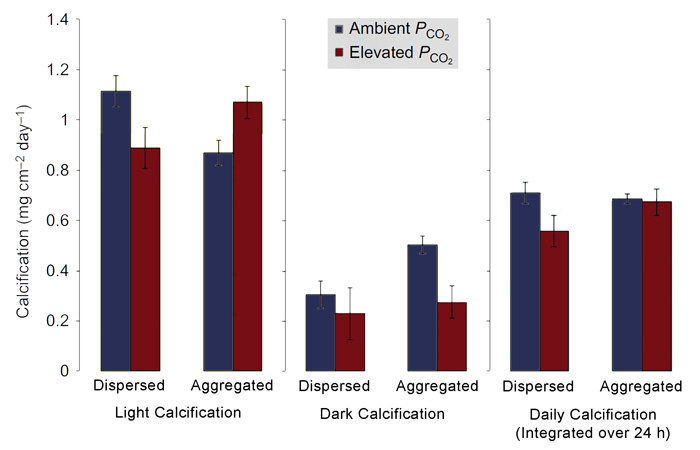| Follow @co2science |
Paper Reviewed
Evensen, N.R. and Edmunds, P.J. 2017. Conspecific aggregations mitigate the effects of ocean acidification on calcification of the coral Pocillopora verrucosa. Journal of Experimental Biology 220: 1097-11050.
Competition for space is often perceived as a limiting factor in the overall health of an ecosystem, as crowded conditions can limit a species ability to acquire the necessary resources for the full expression of its development and growth. However, researchers are beginning to acknowledge that congestion and competition for space can also yield benefits through a process known as facilitation, in which species interaction improves fitness and overall community structure instead of hindering it.
A timely example of facilitation with direct application to the climate change debate was recently published in the Journal of Experimental Biology by Evensen and Edmunds (2017). In that article, the pair of marine researchers hypothesized that coral reef colonies might be able to mediate or even reverse the negative effects of predicted ocean acidification on their rates of calcification. Specifically, it was their premise that coral colony density would alter the seawater flow regimes experienced by the colony, which would then modify the flux of metabolites between coral tissue and seawater, thereby altering the rates of important physiological functions such as calcification, photosynthesis and respiration. As they explain, "under future predicted partial pressure of CO2 (PCO2) conditions (i.e. ocean acidification; OA), at least some of the inhibitory consequences of low flow speeds for the metabolism of reef corals could be reversed, particularly for calcification (Chan et al., 2016), adding that "this outcome is hypothesized to occur because slow seawater flow results in thickening of the diffusive boundary layer (DBL), which favors an increased pH in the seawater above the coral tissue as a result of CO2 uptake by photosynthesis (Chan et al., 2016), with the potentially important outcome of reducing the overall sensitivity of calcification to OA (McCulloch et al., 2012)." Consequently, the two scientists designed an experiment to determine if this mediation of ocean acidification is indeed possible.
To accomplish their objective, Evensen and Edumunds measured the physiological performance of multiple Pocillopora verrucosa colonies in a laboratory setting where they were placed in different densities (low, with branch tips ~8 cm apart, or high, with branch tips ~0.5 cm apart) within a flume held at a constant flow speed under ambient (8.0) or reduced (7.7) seawater pH, corresponding to ambient and elevated PCO2 values of 400 and 1188 µatm, respectively. Results of their analysis are shown in the figure below.

Figure 1. Light, dark and integrated daily calcification of Pocillopora verrucosa colonies in dispersed (low) and aggregated (high) densities under ambient (~400 µatm) or high PCO2 (1188 µatm) seawater.
As can be seen there, calcification in the light (daytime) was negatively influenced by elevated CO2 in the low density treatment (decreased by 20 percent), but enhanced in the high density treatment (increased by 23 percent). What is more, as noted by Evensen and Edmunds, "despite mean calcification in the dark of densely aggregated corals declining by 45% at 1188 µatm PCO2 compared with at ambient PCO2, increased calcification in the light under the same PCO2 resulted in densely aggregated corals maintaining calcification rates ... that were comparable to those maintained under ambient PCO2" (emphasis added). The scientists also found that neither colony density nor PCO2 had any impact on gross photosynthesis, dark respiration, or net photosynthesis, suggesting that "the changes in calcification rate attributed to colony density were not directly associated with photosynthesis or respiration." Rather, it was their belief that "reduced flow speeds among colonies in the flume [were the] plausible mechanism underlying the reduced negative effects of elevated PCO2 on calcification of corals in high-density aggregations," adding that "reduced water flow and increased DBL thickness adjacent to the tissues of the densely aggregated colonies may have acted in concert with CO2 uptake through photosynthesis by endosymbiotic Symbiodinium to elevate seawater pH in the DBL during the day (Chan et al., 2016)."
Regardless of the actual mechanism responsible for the densely aggregated corals to maintain calcification rates in the face of ocean acidification, the study of Evensen and Edmunds, in their words, offers "a compelling case for differential densities of branching coral colonies (i.e. aggregation types) mediating the sensitivity of coral communities in at least some habitats" and it further supports "recent indications that neighboring organisms, such as conspecific coral colonies in the present example, can create small-scale refugia from the negative effects of ocean acidification" And that is more good news for those concerned about the future health of these important marine ecosystems.
References
Chan, N.C.S., Wangpraseurt, D., Kuühl, M. and Connolly, S.R. 2016. Flow and coral morphology control coral surface pH: implications for the effects of ocean acidification. Frontiers of Marine Science 3: 10.
McCulloch, M., Falter, J., Trotter, J. and Montagna, P. 2012. Coral resilience to ocean acidification and global warming through pH up-regulation. Nature Climate Change 2: 623-627.
Posted 5 June 2017



